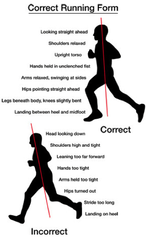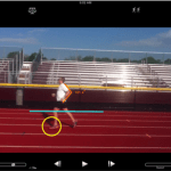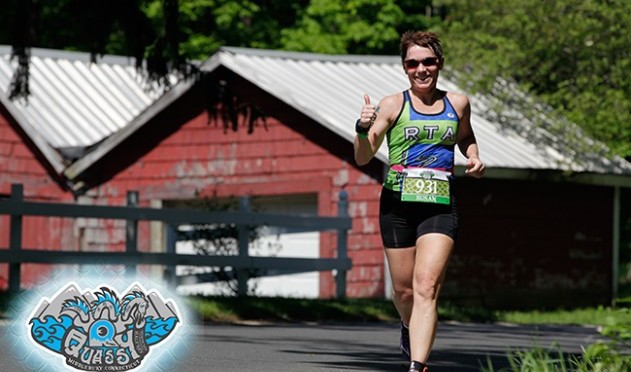|
Learning and practicing proper run form and developing run economy will serve all endurance athletes well. Beginner to professional – this is one of the best ways to run stronger and longer while reducing the risk of injury. Most athletes new to the endurance arena, namely runners and triathletes, overlook or discount the importance of learning the fundamentals of running. I suspect this may be the case for several reasons, but quite simply, humans are land animals. When we want to run, we run. Unlike swimming, where proper form has a major impact on forward movement and successfully swimming, you can easily fudge running for at least a mile or two While running a couple miles is great for most people, if endurance events (10k, Half Marathon, Triathlon, ect) are what you’re interested in, the first couple miles are usually just the warm up. As athletes train to run longer and/or faster, form and economy play an increasingly important role. And remember, run related injuries affect OVER 60-65% of runners each year and are by far the most common among endurance athletes. Below we will go through the basics of proper run form as well as touch on 3 vital components of improving your run economy. Proper Run Form & Economy  The biomechanics of running is the form component of running. Good biomechanics improves speed and helps prevent injury. Proper form enables running to be more enjoyable and helps improve your economy allowing you to run longer and stronger while helping to reduce the risk of injury. In other words, proper run form and economy will increase your body’s “miles per gallon” allowing you to go further using less energy. Runner’s World has a great introductory breakdown of Perfect Run Form, which is a great place to familiarize yourself with how you should look. However, knowing how you SHOULD look and how you ACTUALLY look is where a coach or friend can be a big help. A few items I’d like to extra points I’ll touch on below include where your feet should fall, cadence and vertical oscillation. Where do your feet land?  Your foot should land underneath you as opposed to out in front of you. By landing each foot fall under your center of gravity you will naturally be more likely to land on the forefront of your foot and with a flexion knee. This will help best absorb the impact of each step. The forefront of your foot is between your toes and heal, specifically right between the “knobs” of your foot. This is the ideal place to land. By landing here your body will absorb the force exerted on each leg much more efficiently. If you only run a few miles a week you may never experience the consequences associated with heal striking, however, as you increase your mileage the risk of injury goes up. TEST 1: Jump straight up in the air, about a foot off the ground, and land on your heels. OUCH! This is essentially what your body is absorbing with each stride you take when running if you’re a heel striker. TEST 2: Take off your sneakers and try running 100 yards. You’ll probably notice that you naturally land on the forefront of your feet as you run; absorbing the force your body creates quite nicely. NICE! Additionally, as a heel striker you’re essentially putting on the breaks each time your foot lands. Think about this for a second… if you run this way, each time your foot hits the ground your heal digs in and essentially breaks or slows a lot of the forward movement you’ve created. Not only that, but instead of going instantly into your next step you have roll from your heal to the forefront of your foot to push off for your next step forward. Needless to say, this is not very efficient. Run Cadence What is run cadence? Run cadence is the number of steps per minute an athlete takes while running. Cadence is typically measured by the number of times ONE foot hits the ground over a minute. However some of the new Garmin devices measure BOTH feet. It doesn’t matter. Similar to cycling cadence, as you run, you should strive for a cadence of about 90. You may have noticed many elite marathoners appear to float along as they run, barely touching the ground and at a cadence in the high 90’s this is no surprise. What’s the BIG Deal? Run cadence is important for a couple reasons. First, the higher your cadence the less amount of time your foot is on the ground. The less time your foot is on the ground, the less impact your body absorbs with each stride. Second, cadence is the same as stride rate and stride rate multiplied by stride length equals speed. Stride Rate x Stride Length = Speed Most untrained athletes run at a cadence of about 80. Anyone can have a high cadence when sprinting or running fast, but most cannot sustain that pace. The trick here, is learning to increase your cadence (or turnover) when running slow or at a comfortable pace so that your heart rate does not spike. This takes practice and patience, but if you are diligent it WILL PAY OFF. Not only will your body thank you, but if you can increase your cadence by 5 while holding your HR steady, you’ll be able to knock off 2 minutes (or more) over 10k (6.2mi). You can easily check your cadence by counting the number of foot falls over :15 seconds and multiplying that number by 4. Manually counting is a great place to start, but I often find this to be a misleading way to check your cadence. When athletes count their steps manually, more often than not they’ll hit the target of 90 even if they’d normally never come close. As a result, I don’t believe this is the best method of training yourself to run at the proper rate. I prefer using Garmin’s foot pod or newer Garmin watches, which counts for me. This way there’s no cheating. Another great tool to use while learning to run at a 90 cadence is a metronome. You can set the device to beep at 180 beats per minute. Each beep will represent a foot fall. I recommend running with it on first a few times and then alternate turning if ON and OFF throughout your run to “check in” to see if you’re holding a 90 cadence. Remember, it is important to practice this while running at a slow comfortable rate. You must avoid increasing your pace in order to hit the proper cadence. The more you practice, the easier it will become. What is vertical oscillation? While watching people run it is not uncommon to see athletes run with a bounce or spring in their step/stride. Vertical oscillation is the up and down movement that occurs with each stride. While everyone will “bounce” slightly while they run, the goal is to reduce this as much as possible. Too much bounce, wastes energy and decreases the distance forward with each stride. You can help reduce your vertical oscillation by trying not to lift your knee so much when running. In order words, all your energy should be behind you, not in front of you. Another way to think of it is to drive your knee FORWARD in the direction you’re going and NOT UP & FORWARD (which will create extra oscillation). Fellow USAT Coach, Kelly Wisolik does a great job at explaining this below. “Lifting versus pushing is the concept that is better described as “muscling versus springing.” In distance running, an athlete does not want to “lift.” Lifting means “launching.” This involves a lot of muscular use as it requires power and strength to lift and launch forward. It’s good for power running like football and basketball players and track sprinters. But this extra energy expenditure is not advantageous for distance runners and triathletes. Lifting pulls the chest up and not only uses more muscles but more oxygen too! Lifting occurs when the stretch-shortening cycle is not effectively being employed during the running stride. Pushing is the idea of pushing off the extended leg during the running stride. Pushing is an effective use of the tendons and momentum. Dropping the knee, leaning forward and springing from extension engages the natural reaction of the Golgi Tendon. This conserves muscles and oxygen and therefore is good for distance runners and triathletes. This is the concept of “dab and push forward,” “drop and spring” and “lean and push” which reduces power loss unlike “lift and pull.”” While the description above is well written, sometimes is best to just pretend like you have a glass of water (or wine) on the top of your head and you’re trying not to let it spill. Be Smart Many athletes find it invaluable to seek out a local coach to take a look at your form (swim, bike and/or run) and help correct it. Clinics offered by local run/bike shops and triathlon clubs are another option. Whether you’re looking to improve your economy and make you a little faster or if you’re mostly concerned with injury prevention, working on proper run form is well worth the effort.
Comments are closed.
|
Categories
All
Archives
July 2024
|
RTA TriathlonRTA is a comprehensive triathlon coaching organization and fully supported USAT sanctioned triathlon club.
We are based in Ridgewood, NJ and coach triathletes of all abilities from across the country. Our mission is to make you a better triathlete. Contact us when you're ready to take your "game" to the next level. |
|
|
Quick Links |
Let's get social
RTA Triathlon
Copyright © 2022
Copyright © 2022


 RSS Feed
RSS Feed
